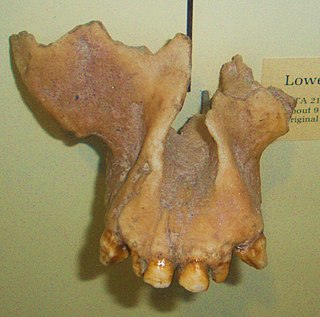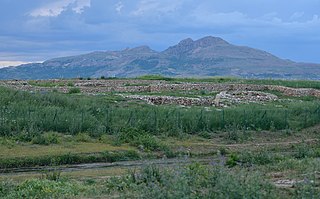 W
WThe prehistory of Anatolia stretches from the Paleolithic era through to the appearance of classical civilisation in the middle of the 1st millennium BC. It is generally regarded as being divided into three ages reflecting the dominant materials used for the making of domestic implements and weapons: Stone Age, Bronze Age and Iron Age. The term Copper Age (Chalcolithic) is used to denote the period straddling the stone and Bronze Ages.
 W
WThe Anatolian hypothesis, also known as the Anatolian theory or the sedentary farmer theory, first developed by British archaeologist Colin Renfrew in 1987, proposes that the dispersal of Proto-Indo-Europeans originated in Neolithic Anatolia. It is the main competitor to the Kurgan hypothesis, or steppe theory, the more favoured view academically.
 W
WAnkarapithecus is a genus of extinct ape. It was probably frugivorous, and would have weighed about 27 kilograms (60 lb). Its remains were found close to Ankara in central Turkey beginning in the 1950s. It lived during the Late Miocene and was similar to Sivapithecus.
 W
WÇayönü Tepesi is a Neolithic settlement in southeastern Turkey which prospered from circa 8,630 to 6,800 BC. It is located forty kilometres north-west of Diyarbakır, at the foot of the Taurus mountains. It lies near the Boğazçay, a tributary of the upper Tigris River and the Bestakot, an intermittent stream.
 W
WDomuztepe was a large, late Neolithic settlement in south east Turkey, occupied at least as early as c.6,200BC and abandoned c.5,450BC. The site is located to the south of Kahramanmaraş. Covering 20 hectares, it is primarily a Halaf site of the 6th millennium BC and is the largest known settlement of that date.
 W
WHomo erectus is an extinct species of archaic human from the Pleistocene, with its earliest occurrence about 2 million years ago, and its specimens are among the first recognisable members of the genus Homo. H. erectus was the first human ancestor to spread throughout the Old World, having a distribution in Eurasia extending from the Iberian Peninsula to Java. African populations of H. erectus are likely to be the direct ancestors to several human species, such as H. heidelbergensis and H. antecessor, with the former generally considered to have been the direct ancestor to Neanderthals and Denisovans, and sometimes also modern humans. Asian populations of H. erectus may be ancestral to H. floresiensis and possibly to H. luzonensis. As a chronospecies, the time of the disappearance of H. erectus is a matter of contention. There are also several proposed subspecies with varying levels of recognition. The last known record of morphologically recognisable H. erectus are the Solo Man specimens from Java, around 117–108,000 years ago.
 W
WThe Kura–Araxes culture, also named Kur–Araz culture, or the Early Transcaucasian culture was a civilization that existed from about 4000 BC until about 2000 BC, which has traditionally been regarded as the date of its end; in some locations it may have disappeared as early as 2600 or 2700 BC. The earliest evidence for this culture is found on the Ararat plain; it spread northward in Caucasus by 3000 BC.).
 W
WThe prehistory of Anatolia stretches from the Paleolithic era through to the appearance of classical civilisation in the middle of the 1st millennium BC. It is generally regarded as being divided into three ages reflecting the dominant materials used for the making of domestic implements and weapons: Stone Age, Bronze Age and Iron Age. The term Copper Age (Chalcolithic) is used to denote the period straddling the stone and Bronze Ages.